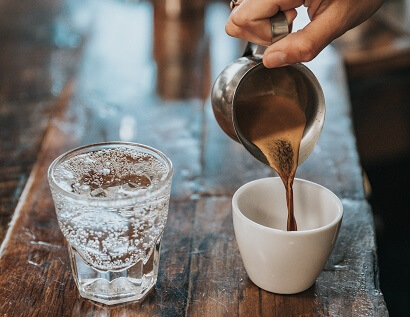There’s an art to serving Greek coffee. It’s not simply a matter of pouring the delicious liquid into a cup and slurping it down. For a more traditional experience, there’s a specific way to serve it; especially if you want to have a Greek-themed coffee party.

To serve Greek coffee, use a small spoon to remove the thick foam from the surface of your cooking vessel and distribute it in small cups. Then slowly pour the coffee into the cups, wait 5 minutes for the coffee grounds to settle, and serve the coffee with a glass of water.
The reason for the pomp and circumstance around coffee is due to the Greek propensity for socializing and hospitality. It’s a way for people to get together, talk, laugh and enjoy each other’s company.
Taking Preference Orders
When you have a group of people you’re serving Greek coffee to, you should know ahead of time what kind of a sweet tooth they have. This is because you’ll need to determine how much sugar to add prior to boiling the coffee. There are four types to offer guests:
- Glykos (pronounced glee-k-ose): Sweet but not overpowering
- Metrios (pronounced meh-tree-ose): A scant bit of sugar
- Sketos (pronounced skeh-t-ose): Black without sugar at all
- Vary Glykos (pronounced vah-ree glee-k-ose): Highest level of sweetness possible
Once you understand how everyone wants their coffee, start with those who want it plain black. Then work your way up to the one who wants it vary glykos. This is to prevent any more sugar from entering someone’s cup who doesn’t want it, especially if they have something like diabetes.
Serve in a Demitasse Cup
Once you’ve finished brewing Greek coffee in a briki, it’s time to pour. But, only after you’ve achieved that great, thick foam toward the top of this brewing pot. Known as kaïmaki, this is essential before pouring to get the best flavors from the coffee while providing an aesthetic presentation.
When you pour the coffee, put them into little cups called a “demitasse.” These are about half the size of a regular coffee mug. They typically measure approximately 2½ inches by 2½ inches and come with a four-inch saucer. Demitasse cups can hold about two to three ounces of coffee.
Some people mischaracterize these as espresso cups or the French-style chocolate cups, but they are a class all their own. While it may seem far too small, remember, Greek coffee is a brew that comes highly concentrated. Therefore, you don’t need a monster-sized mug for it.
How to Pour Greek Coffee
To begin pouring, don’t just dump the contents from the briki into the cup, this will produce disastrous results. Rather, spoon the foam into each cup so that it distributes evenly. Then, hold the rim of the cup up to the pour spout of the briki and tilt at a gentle angle so that the coffee delicately streams.
When you have a solid pour going, allow the coffee to stretch as you lift the briki straight up from the cup. Then, move it closer to the cup as the coffee reaches the top. Not only will this provide a bit of entertainment value for those you’re serving, but it will help the coffee cool.
While pouring the coffee from the briki into the demitasse cup, allow the grounds to fall in with it. This is why pouring slowly is important, to avoid too much from entering. Another reason to pour slowly is that it will take the grounds longer to settle.
Wait for Grounds to Settle
The settling time is an important social aspect of Greek coffee. Once you have your coffees poured into the demitasse cups, wait for at least five to 10 minutes to allow the settling process to begin. This is essential so that you and your guests don’t accidentally drink some of the grounds floating around.
But, it’s during this time everyone can strike up an intriguing conversation. Before you all know it, the grounds will settle and the coffee will be cool enough to sip on.
Why Is Greek Coffee Unfiltered?
Because the brewing process for Greek coffee is a very traditional method, the grounds stay in the cup. There is no filtration applied at all. This provides a continued steeping long after the brewing process and keeps the coffee strong and robust.
Why Is Greek Coffee Served with Water?
Because of the intense nature of Greek coffee, it’s important to serve it with water. This help with any dehydration that can occur because of the heat or strength inherent within the coffee. Alternatively, water is a great chaser in the event a few grounds get into the mouth unintentionally.
Plus, Greek coffee has a lot of mouthfeel to it. This means it has a noticeable and distinct texture while drinking it. Water is a beautiful way to cleanse the palette and mitigate this sensation.
How to Drink Greek Coffee
Drinking Greek coffee is just as much of an art as it is to make and serve it. The most important component here is patience and a willingness to take things slow. You can’t just gulp down a cup because you’re in a rush. The intention here is to enjoy and savor the cup along with the company around you.
Take small, pristine sips and allow the brew to roll around your tongue. Follow this with a bite of a pastry like a doughnut or baklava and/or a few sips of water. Doing this will further allow grounds to settle as well as give taste buds a break from the concentrated caffeine.
When everyone finishes their coffee, there’s an old fortunetelling custom you can do. Take the saucer, place it over the top of the cup so the thick sludge slides down the sides. Turn the cup over and attempt identifying the patterns or images. This will tell the person who drank from that cup what their future will be.
- The Top Restaurants Specializing in Truffle Dishes - August 10, 2023
- Truffle Panna Cotta: A Decadent Dessert Recipe for Truffle Lovers - August 7, 2023
- Truffle Scrambled Eggs: A Luxurious Breakfast Delight - August 7, 2023








